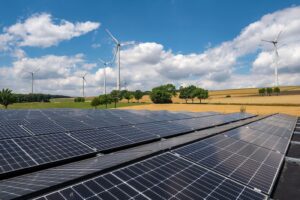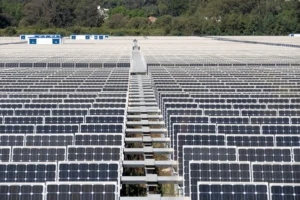Extreme “wind droughts” that reduce power output from turbines for extended periods could become 15% longer by the end of the century across much of the northern hemisphere under a moderate warming scenario.
That is according to a new study in Nature Climate Change, which explores how climate change could impact the length and frequency of prolonged low-wind events around the world.
According to the study, “prominent” wind droughts have already been documented in Europe, the US, northeastern China, Japan and India.
As the planet warms, wind droughts will become longer in the northern hemisphere and mid-latitudes – especially across the US, northeastern China, Russia and much of Europe – the paper says.
The study – which focuses on onshore wind – warns that “prolonged” wind droughts could “threaten global wind power security”.
However, they add that research into the effects of climate change on wind supply can help “prepare for and mitigate the adverse impacts” of these prolonged low-wind events.
Combining wind power with other energy technologies – such as solar, hydro, nuclear power and energy storage – can help reduce the impact of wind droughts on global energy supply, the study says.
One expert not involved in the research tells Carbon Brief that the findings do not “spell doom for the wind industry”.
Instead, he says the study is a “navigation tool” which could help the energy industry to “counteract” future challenges.
Wind drought
Wind power is one of the fastest-growing sources of energy in the world and currently makes up around 8% of global electricity supply. It is also playing a crucial role in the decarbonisation of many countries’ energy systems.
Wind is the result of air moving from areas of high pressure to areas of low pressure. These differences in air pressure are often due to the Earth’s surface being heated unevenly.
Human-caused climate change is warming the planet’s atmosphere and oceans. However, different regions are heating at different rates, resulting in a shift in global wind patterns. The IPCC finds that global average wind speeds (excluding Australia) slowed down slightly over 1979-2018.
There have already been dozens of recorded instances of prolonged low-wind events, known as wind droughts, which can drive down power production from wind turbines.
Dr Iain Staffell is an associate professor at the Centre for Environmental Policy at Imperial College London who was not involved in the study. He tells Carbon Brief that wind droughts often “push up power prices” as countries turn to more expensive alternative energy supplies, such as fossil fuels.
For example, Staffell tells Carbon Brief that, in the winter of 2024-25, Germany saw an “extended cold-calm spell which sent power prices to record highs”. (In German, this type of weather event is referred to as a “dunkelflaute”, often translated as “dark doldrums”.) He adds:
“It’s important to note that I’m not aware of anywhere in the world that has suffered a blackout because of a wind drought.”
Capacity factor
The productivity of wind power sites is often measured by their “capacity factor” – the amount of electricity that is actually generated over a period of time, relative to the maximum amount that could have been generated in theory.
A capacity factor of one indicates that wind turbines are generating the maximum possible amount of electricity, while zero indicates that they are not producing any power.
The authors define a wind drought as the 20th percentile in each grid cell – in other words, winds ranking in the slowest bottom fifth of winds typically recorded in the region.
They look at the frequency of prolonged wind droughts and how that might change as the world warms.
The map below shows regions’ average capacity factor at 100 metres above the ground level, derived from the ERA5 reanalysis data over 1980-2022, where darker shading indicates a higher capacity factor.
It also shows 19 wind droughts recorded since the year 2000 across Europe, the US, northeastern China, Japan and India. Wind droughts are indicated by yellow triangles for local events and hashed areas for larger-scale events.\

The map also shows that the darker shading for “abundant wind resources” is typically found in the mid-latitudes near “major storm tracks”, including the central US, northern Africa, northwestern Europe, northern Russia, northeastern China and Australia.
Modelling wind
To assess the severity of past and future wind droughts, the authors consider both the frequency and duration of these low-wind events.
To calculate wind drought duration, the authors use reanalysis data and models from the sixth Coupled Model Intercomparison Project (CMIP6) – the international modelling effort that feeds into the influential assessment reports from the Intergovernmental Panel on Climate Change (IPCC).
The authors then look at how wind drought conditions may change in the future, by modelling wind speeds over 2015-2100 under a range of future warming scenarios.
They find that wind drought frequency and duration will both increase in the northern hemisphere and mid-latitudes by the end of the century. The authors identify “particularly notable increases” in wind drought frequency in the US, northeastern China, Russia and much of Europe.
In the northern mid-latitudes, there will be a one-to-two hour increase in average wind drought duration by the end of the century under the moderate SSP2-4.5 scenario, according to the study. This is a 5-15% increase compared to today’s levels.
The authors also assess “extreme long-duration events” by looking at the longest-lasting wind drought that could happen once every 25 years.
The study projects roughly a 10%, 15% and 20% “elongation” in these long-duration wind droughts across “much of the northern mid-latitude regions” under the low, moderate and very high warming scenarios, by the end of the century.
However, the authors find “strong asymmetric changes” in their results, projecting a decrease in wind drought frequency and intensity in the southern hemisphere.
The authors suggest that the increase in wind droughts in the northern hemisphere is partly because of Arctic amplification – the phenomenon whereby the Arctic warms more quickly than the rest of the planet.
Accelerated warming in the Arctic narrows the temperature gap between the north pole and the equator and alters atmosphere-ocean interactions, which reduces wind speeds in the northern hemisphere.
Conversely, the authors suggest that increasing wind speeds in the southern hemisphere are caused by the land warming faster than the ocean, resulting in a greater difference in temperature between the land and the sea.
Record-breaking wind droughts
Finally, the authors also investigate the risk of “record-breaking wind droughts” – extreme events that would only be expected once every 1,000 years under the current climate.
They use CMIP6 models, based on historical data over 1980-2014, to assess how long-lasting such an event would be in different regions of the world. These results are shown on the map below, where darker brown indicates longer-duration wind droughts.

These 1,000-year record-breaking wind droughts typically last for 150-350 hours (6-15 days), occasionally reaching up to 400 hours in regions such as India, East Russia, east Africa and east Brazil, the paper says.
The authors go on to assess the risk of record-breaking wind droughts for existing wind turbines under different warming scenarios.
The plot below shows the fraction of the CMIP6 models used in this study that project record-breaking wind droughts for onshore wind turbines.
Blue bars show the percentage of wind turbines that face a “weak” risk of exposure, meaning that fewer than 25% of models predict that the turbine will be exposed to record-breaking wind droughts by the year 2100. Green bars indicate a “moderate” risk of 25-50% and brown bars denote “severe” risk of greater than 50%.
Each panel shows a different region of the world, with results for low (left) moderate (middle) and very high (right) warming scenarios.
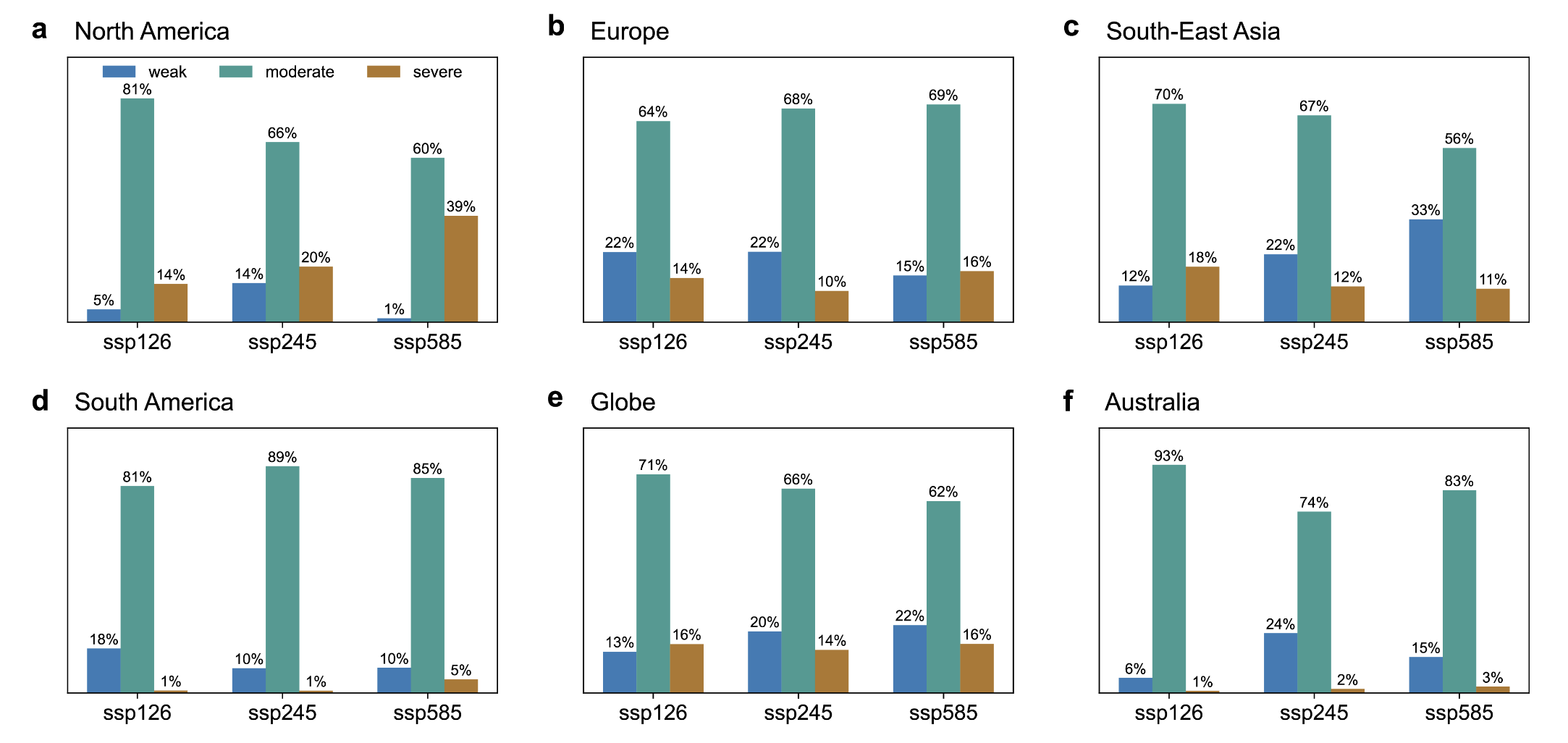
The study finds that, globally, around 15% of wind turbines will face “severe” risk from record-breaking wind droughts by the end of the century, regardless of the future warming scenario. However, different parts of the globe are expected to face different trends.
In North America, the percentage of turbines facing a “severe” risk from such extended wind droughts in the year 2100 rises from 14% in a low warming scenario to 39% in a very high warming scenario. Europe also faces a higher risk to its wind turbines under higher emissions scenarios.
However, the trends vary across the world. In south-east Asia, for example, the percentage of wind turbines at “severe” risk of the longest wind droughts drops from 18% under a low warming scenario to 11% under a very high warming scenario.
Energy security
The planet currently has 1,136GW of wind capacity. The authors say that, according to a report by the International Renewable Energy Agency, “wind power capacity is projected to grow substantially as the world pursues decarbonisation, aiming for 6,000GW by 2050”.
The paper sets out a number of ways that energy suppliers could reduce their exposure to record-breaking wind droughts.
The authors say that developers can avoid building new turbines in areas that are prone to frequent wind droughts. They add:
“Other effective mitigation measures include complementing wind power with other renewable energy sources, such as solar, hydro, nuclear power and energy storage.”
Staffell tells Carbon Brief the study provides helpful insights for how the world’s power supply could be made less vulnerable to prolonged low-wind events:
“I don’t see this study as spelling doom for the wind industry, instead it’s a navigation tool, telling us where to expect challenges in future so that we can counteract them.”
Staffell argues that there are “many solutions” for combatting wind droughts – including building the infrastructure to enable “more interconnection” between countries’ power grids.
For example, he says the UK could benefit from connecting its grid to Spain’s, noting that “wind droughts in the UK tend to coincide with [periods of] higher wind production in Spain”.
He adds:
“Increasing flexibility and diversity in power systems is a way to insure ourselves against extreme weather and cheaper than panic-buying gas whenever the wind drops.”
Similarly, Dr Enrico Antonini, a senior energy system modeller at Open Energy Transition, who was not involved in the study, tells Carbon Brief that wind droughts “do not necessarily threaten the viability of wind power”. He continues:
“Areas more exposed to these events can enhance their resilience by diversifying energy sources, strengthening grid connections over large distances and investing in energy storage solutions.”
In a news and views piece about the new study, Dr Sue Ellen Haupt, director of the weather systems assessment programme at the University of Colorado, praises the “robust” analysis.
She says the work “would ideally be accomplished with higher-resolution simulations that better resolve terrain, land-water boundaries and smaller-scale processes”, but acknowledges that “such datasets are not yet available on the global scale”.
Meanwhile, Dr Frank Kaspar is the head of hydrometeorology at Germany’s national meteorological service. He tells Carbon Brief how additions to this study could further help energy system planning in Germany.
Kaspar tells Carbon Brief it would be helpful to know how climate change will affect seasonal trends in wind drought, noting that in Germany, wind power “dominat[es] in winter” while solar plays a larger role in the energy mix in summer. [The UK sees a similar pattern.]
He adds that the study does not address offshore wind – a component of Germany’s energy mix that is “important” for the country.
The post Climate change could make ‘droughts’ for wind power 15% longer, study says appeared first on Carbon Brief.
Climate change could make ‘droughts’ for wind power 15% longer, study says
Climate Change
10 reasons why we need to act for the Amazon
The Amazon isn’t just the world’s greatest rainforest. She has been home to her original people for tens of thousands of years, who have persisted through centuries of colonial incursions to protect their home. At each moment of each day, the Amazon breathes, dances, and sings with an endless variety of plants and animals, many of those we humans have yet to understand. The Amazon is life-giving, irreplaceable and yet profoundly vulnerable.
Here are 10 fascinating facts to inspire you to take action for the Amazon:
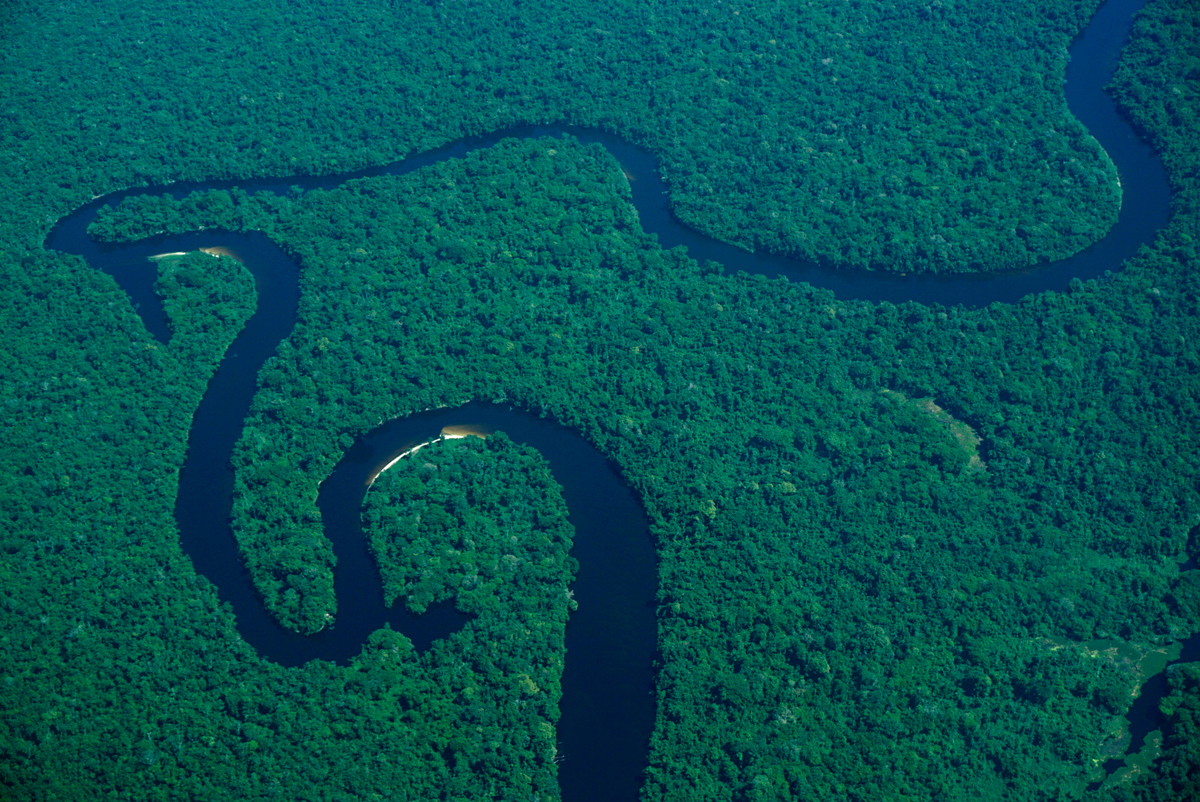
1- The Amazon is the largest rainforest in the world
Spanning over nine countries in South America, the Amazon is the largest tropical forest on the planet, covering 6.7 million square kilometres. To put it in perspective, she is twice the size of India—the largest country in South Asia. The biggest part, around 60%, is in Brazil. After the Amazon, the Congo Basin and Papua host the world’s largest remaining rainforests.
2- The Amazon is one of the most biodiverse ecosystems on Earth
The Amazon is home to approximately 10% of all known species of fauna and flora worldwide. From the beautiful hyacinth macaws to fearless jaguars and the amazing pink dolphins, this vibrant ecosystem is teeming with life. In some areas, a single hectare can contain more than 300 tree species, approximately two-thirds of the native tree species in Europe (454), making the Amazon one of the most botanically rich regions on Earth.
Studies show that the Amazon Basin harbours at least 2,716 species of fish, 427 amphibians, 371 reptiles, 1,300 birds, and 425 mammals. However, the vast majority of its biodiversity lies in her invertebrates, particularly insects, with over 2.5 million species currently known

3- There are approximately 3 million Indigenous People living in the Amazon
The Amazon is home to a diverse group of Indigenous Peoples. Over 390 Indigenous Peoples live in the region, along with approximately 137 isolated groups, who have chosen to remain uncontacted.
In Brazil, about 51.2% of the country’s Indigenous population resides in the Amazon. But the largest tropical forest in the world is also home to traditional communities that have lived in harmony with the forest for generations, such as Rubber Tappers, Ribeirinhos—who inhabit the Amazon’s riverbanks—and Quilombolas, Afro-Brazilian communities descended from enslaved people..
4- The Amazon is home to over 40 million people
The Amazon is not just a vast rainforest rich in biodiversity and home to Indigenous People—it is also home to several cities. In Brazil, These include Manaus , an industrial hub with a population of 2.2 million, and Belém , which will host the United Nations Climate Conference (COP30) in November 2025.
These people’s lives are intrinsically connected to the forest. They depend on her for their food, fresh water, and to regulate the local climate. Smoke from the fires in the Amazon directly impacts the people living in the region, darkening the skies and causing respiratory problems to the population, especially children and elders.
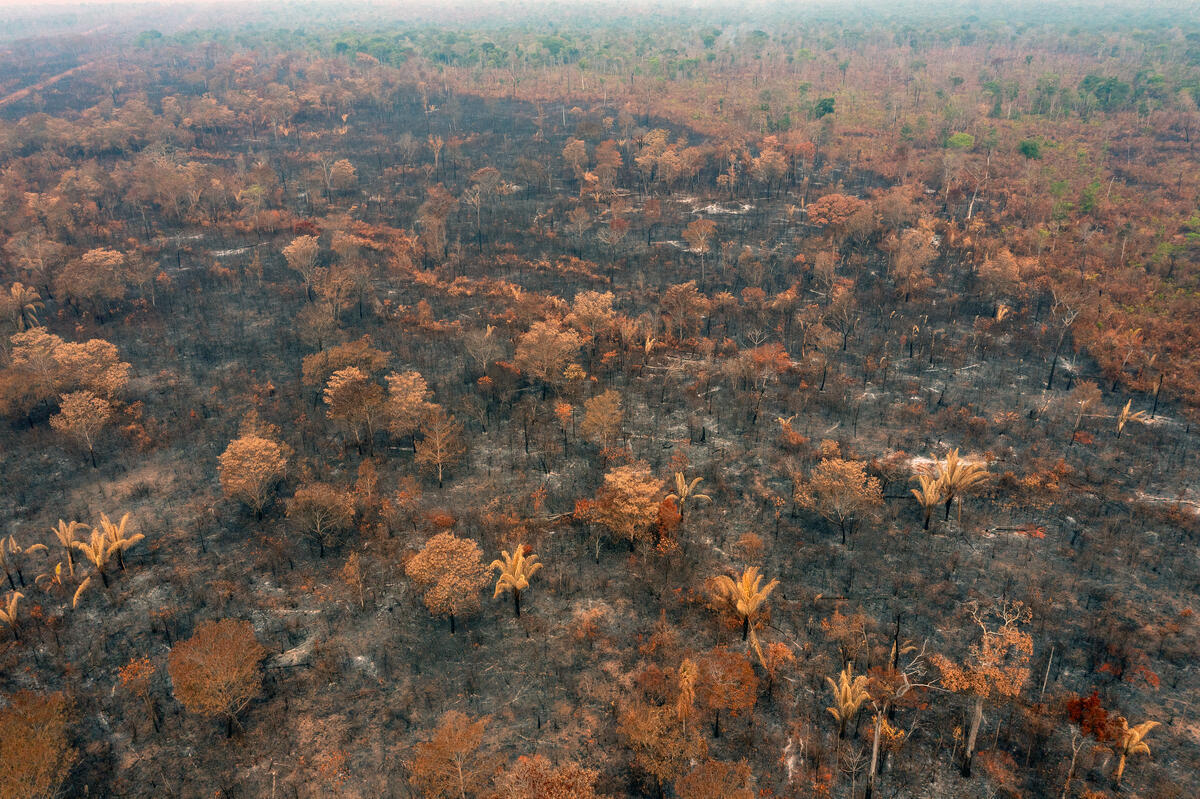
5- The Amazon is vital for the global climate
The Amazon is estimated to store about 123 billion tons of carbon, both above and below ground, making her one of Earth’s most crucial “carbon reserves”, vital in the fight against the climate crisis. However, studies show that fire- and deforestation-affected areas of the Amazon are now releasing more CO₂ into the atmosphere than they absorb. This poses a major threat to the global climate. Protecting the Amazon means protecting the future of everyone.
6- Fires in the Amazon are not natural
Unlike bushfires in Australia and other parts of the world, fires in the Amazon are not natural. In the Amazon biome, fire is used in the deforestation process to clear the land for agriculture and pasture. The use of fire in the Amazon is often illegal, and so is deforestation. This practice has a major impact on the local biodiversity, the health of the populations living in the region, and to the global climate, as the fires release vast amounts of carbon into the atmosphere.
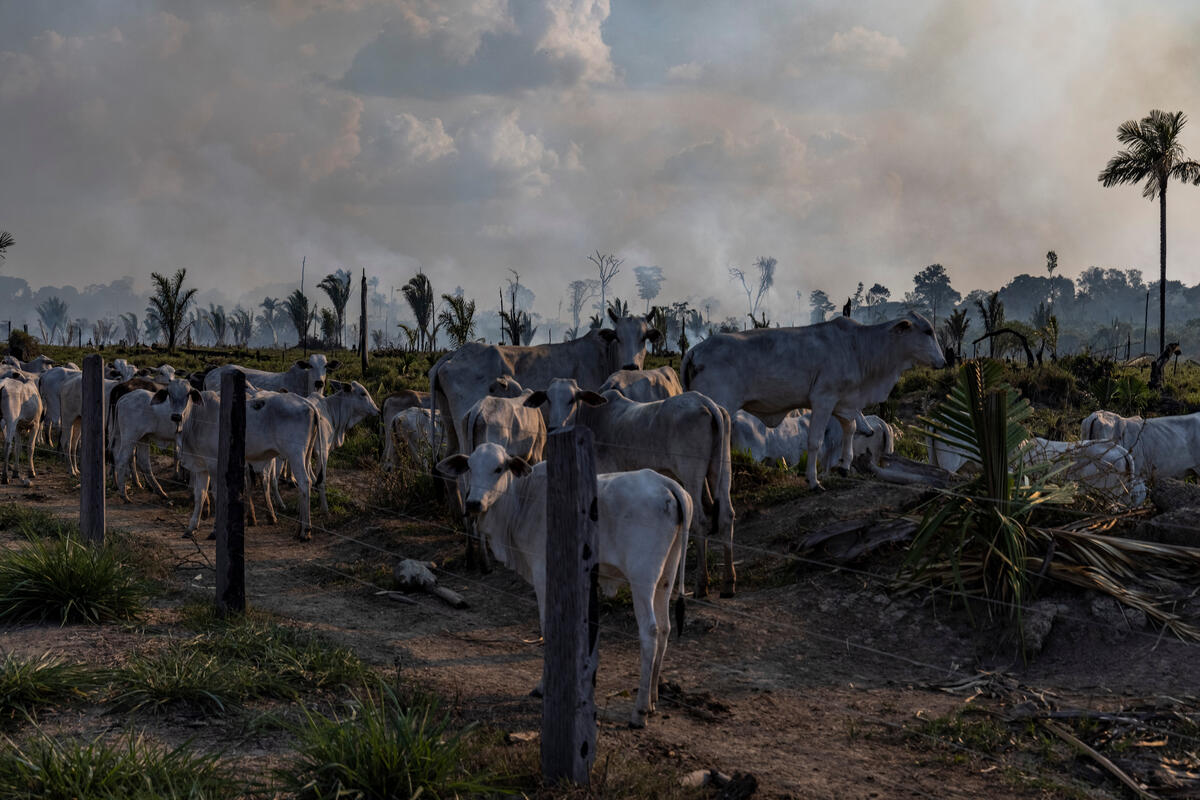
© Victor Moriyama / Amazônia em Chamas
7- Cattle ranching is the leading cause of deforestation in the Amazon
The expansion of agribusiness in the Amazon is putting more and more pressure on the forest. According to a study, 90% of the deforested areas in the Brazilian Amazon are turned into pasture to produce meat and dairy. This means the food we eat may be linked to deforestation in the Amazon. We must urge our governments to stop buying from forest destroyers and ensure supply chains are free from deforestation, and demand stronger protections for the Amazon.
8- Illegal gold mining is a major threat to Indigenous Peoples
Illegal gold mining in Indigenous Lands in Brazil surged by 265% in just five years, between 2018 and 2022. The activity poses a severe threat to the health and the lives of Indigenous People, destroying rivers, contaminating communities with mercury and bringing violence and death to their territories.
But illegal gold mining doesn’t impact just the forest and Indigenous People. A recent study showed that mercury-contaminated fish are being sold in markets in major Amazonian cities, putting the health of millions at risk.
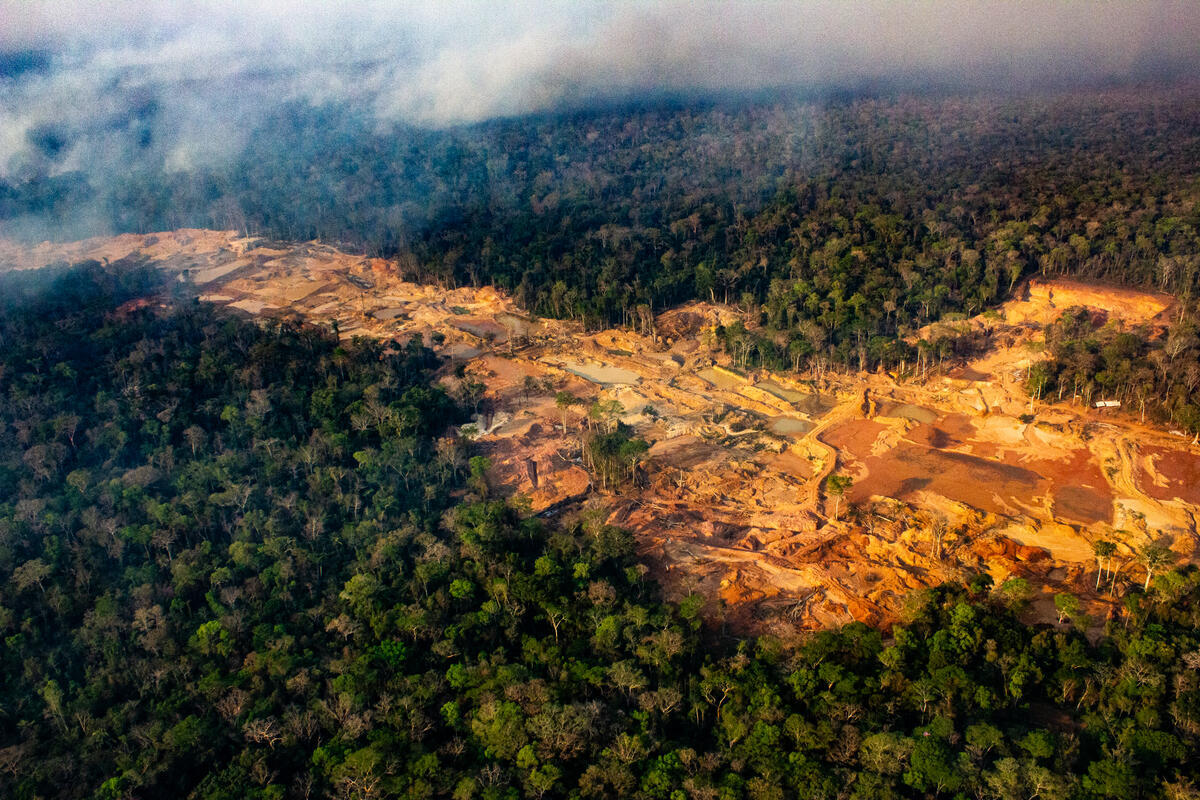
9- The Amazon is close to a point of no return
About 17% of the Amazon has already been deforested, and scientists warn we are getting dangerously close to a ‘point of no return’.
According to a study, if we lose between 20% and 25% of the Amazon, the forest might lose its ability to generate its own moisture, leading to reduced rainfall, higher temperatures, and a self-reinforcing cycle of drying and degradation.
As a result, vast areas of the forest could turn into a drier, savanna-like ecosystem, unable to sustain her rich biodiversity. This could have catastrophic consequences for the global climate, local communities, and the planet’s ecological balance.
10- The most important Climate Conference in the world is happening in the Amazon this year
COP30, the United Nations Climate Conference, will take place in Belém, the second largest city in the Amazon region, in November 2025. During the conference, representatives from countries all over the world will meet to discuss measures to protect the climate. Across the globe, we are already witnessing and feeling the impacts of the climate crisis. This is our chance to demand our political leaders move beyond words to urgent action. They must stop granting permission and public funds to Earth-destroying industries. Instead, our leaders must respect, pursue, and support real solutions that already exist—solutions that put the forest and her people at the heart of the response. Indigenous guardians of the forest hold true authority, and they must be respected and heard. The moment is now.
We are the turning point! Join the movement and demand respect for the Amazon.
Climate Change
As the Data Center Boom Ramps Up in the Rural Midwest, What Should Communities Expect?
The rapid development will change the Corn Belt in significant, unforeseen ways. Residents are just beginning to grapple with what that means.
TAZEWELL COUNTY, Ill.—To the untrained eye, Central Illinois is all lush fields of corn and green soybeans shortly before harvest. The wind shuffles through the row crops, and the air is warm and humid and full of insects. The horizon is dotted with power lines, strung together by wire, and the occasional water tower—the only objects that disrupt a vast sky.
As the Data Center Boom Ramps Up in the Rural Midwest, What Should Communities Expect?
Climate Change
Why Billions of Gallons of Raw Sewage Keep Ending up in Philadelphia Waterways
With a new analysis showing where the pollution is going, environmental advocates call on public officials to do more to stop it.
PHILADELPHIA—Some 280 years after a river-swimming Benjamin Franklin petitioned to curb water pollution here, the city is still struggling to meet the challenge, according to water advocates who assembled along the banks of one of its two main rivers on Monday.
Why Billions of Gallons of Raw Sewage Keep Ending up in Philadelphia Waterways
-
Climate Change2 years ago
Spanish-language misinformation on renewable energy spreads online, report shows
-
Climate Change3 months ago
Guest post: Why China is still building new coal – and when it might stop
-
Climate Change Videos2 years ago
The toxic gas flares fuelling Nigeria’s climate change – BBC News
-

 Greenhouse Gases1 year ago
Greenhouse Gases1 year ago嘉宾来稿:满足中国增长的用电需求 光伏加储能“比新建煤电更实惠”
-
Greenhouse Gases3 months ago
Guest post: Why China is still building new coal – and when it might stop
-

 Climate Change1 year ago
Climate Change1 year ago嘉宾来稿:满足中国增长的用电需求 光伏加储能“比新建煤电更实惠”
-

 Carbon Footprint2 years ago
Carbon Footprint2 years agoUS SEC’s Climate Disclosure Rules Spur Renewed Interest in Carbon Credits
-
Renewable Energy4 months ago
US Grid Strain, Possible Allete Sale

